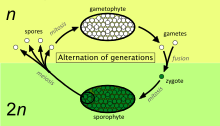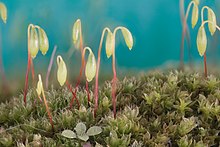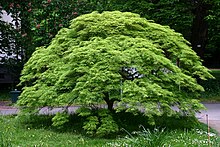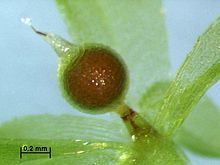Sporophyte

A sporophyte (alga which produces asexual spores. This stage alternates with a multicellular haploid gametophyte phase.
Life cycle
The sporophyte develops from the
seed plants, the largest groups of which are the gymnosperms and flowering plants (angiosperms), the sporophyte phase is more prominent than the gametophyte, and is the familiar green plant with its roots, stem, leaves and cones or flowers. In flowering plants the gametophytes are very reduced in size, and are represented by the germinated pollen and the embryo sac
The sporophyte produces spores (hence the name) by meiosis, a process also known as "reduction division" that reduces the number of chromosomes in each spore mother cell by half. The resulting meiospores develop into a gametophyte. Both the spores and the resulting gametophyte are haploid, meaning they only have one set of chromosomes.
The mature gametophyte produces male or female
The fusion of male and female gametes produces a diploid zygote which develops into a new sporophyte. This cycle is known as alternation of generations
or alternation of phases.
Examples



hornworts) have a dominant gametophyte phase on which the adult sporophyte is dependent for nutrition. The embryo sporophyte develops by cell division of the zygote within the female sex organ or archegonium, and in its early development is therefore nurtured by the gametophyte.[1]
Because this embryo-nurturing feature of the life cycle is common to all land plants they are known collectively as the embryophytes.[citation needed
]

Most algae have dominant gametophyte generations, but in some species the gametophytes and sporophytes are
heterosporous life cycles in which the spores producing male and female gametophytes were of different sizes, the female megaspores tending to be larger, and fewer in number, than the male microspores.[2]
Evolutionary history
During the
nucellus of the parent sporophyte. The evolution of heterospory and endospory were among the earliest steps in the evolution of seeds of the kind produced by gymnosperms and angiosperms today. The rRNA genes seems to escape global methylation machinery in bryophytes, unlike seed plants.[3]
See also
References
Further reading
- Kenrick P, Crane PR (September 1997). "The origin and early evolution of plants on land". Nature. 389 (6646): 33–39. S2CID 3866183.
- Taylor TN, Kerp H, Hass H (April 2005). "Life history biology of early land plants: deciphering the gametophyte phase". Proceedings of the National Academy of Sciences of the United States of America. 102 (16): 5892–7. PMID 15809414.
- Bell PR, Helmsley AR (2000). Green plants. Their Origin and Diversity. Cambridge University Press. ISBN 0-521-64673-1.
